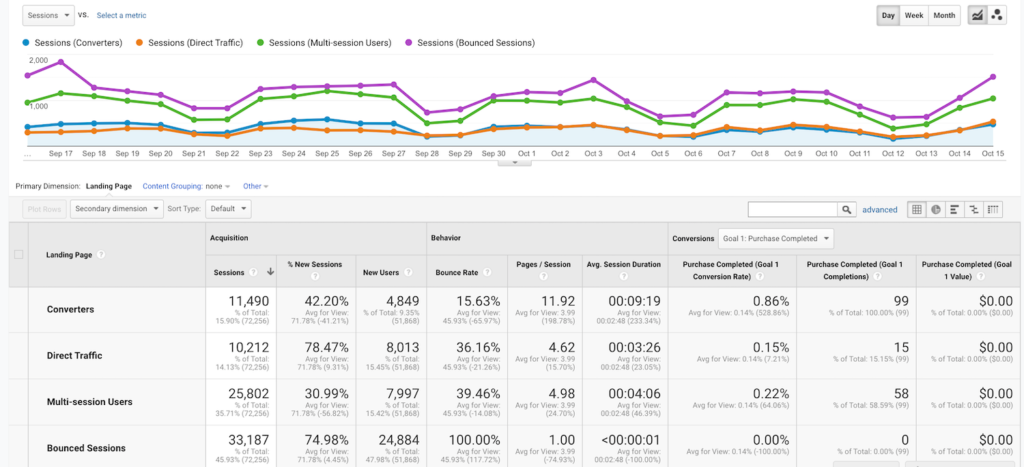Trick Insights on What Data Is Google Analytics Goals Unable to Track
Discover the Limitations of Google Analytics Goals: Introducing the Data Kind That Remain Untrackable
As businesses increasingly rely on data-driven decision-making, recognizing the limitations of tools like Google Analytics ends up being paramount. While Google Analytics Goals deal important insights right into individual interactions, there exist information types that elude monitoring, posturing challenges to a detailed understanding of individual habits.
Incomplete User Journey Tracking
Insufficient customer journey monitoring within Google Analytics can prevent the ability to properly assess user habits. When the individual trip is not totally tracked, there are voids in the information that protect against a thorough understanding of how customers communicate with an internet site. This lack of insight can lead to missed out on possibilities for optimization and renovations to the individual experience.
One common issue with insufficient customer trip monitoring is the failure to see the complete path that individuals take previously completing a goal or leaving the website. Without this information, it is challenging to identify where individuals may be experiencing obstacles or friction points that stop them from transforming. Furthermore, incomplete tracking can obscure the influence of particular marketing efforts or internet site modifications on individual habits.
To resolve this constraint, it is essential to establish up proper tracking devices within Google Analytics to capture the whole customer trip. This may entail establishing up occasion tracking, goal funnels, or using devices like Google Tag Supervisor to make certain that no vital communications go unrecorded. By obtaining an extensive view of the user trip, internet site proprietors can make even more educated choices to enhance individual interaction and drive conversions.
Attribution Challenges
Browsing with attribution difficulties in Google Analytics calls for a detailed understanding of exactly how various touchpoints contribute to the general conversion procedure. Acknowledgment challenges develop from the complexity of modern client trips, where customers engage with numerous channels prior to converting. Google Analytics gives different acknowledgment versions like initial touch, last touch, and straight, each using a different viewpoint on how credit score is assigned to touchpoints along the conversion path. Nonetheless, these designs may not always accurately mirror truth effect of each touchpoint on the conversion.
One typical attribution difficulty is the trouble in attributing conversions to the right source, particularly in cases where individuals connect with multiple channels before converting. This can lead to inaccuracies in determining which advertising and marketing initiatives are driving one of the most conversions. In addition, cross-device tracking poses one more acknowledgment obstacle, as individuals usually switch between tools during their trip, making it challenging to track their interactions flawlessly. Marketers have to very carefully interpret and analyze acknowledgment data to make educated choices and optimize their marketing approaches effectively.
Offline Conversions
Provided the obstacles connected with connecting conversions precisely in online channels, the measurement of offline conversions offers a considerable possibility for marketers seeking a much more detailed understanding of their consumers' trip. Offline conversions refer to actions that consumers absorb the physical globe, such as making purchases in brick-and-mortar shops or over the phone, attending occasions, or involving with published materials - what data is google analytics goals unable to track. These conversions are critical for organizations that run both online and offline, as they provide useful understandings into the effectiveness of advertising and marketing campaigns throughout numerous touchpoints
Tracking offline conversions generally positioned a substantial obstacle for marketers, as it was challenging to connect these activities back to details online communications properly. However, with developments in modern technology, such as the assimilation of CRM systems, one-of-a-kind identifiers, and promo code codes, organizations can now link the gap between online and offline information to get a more all natural sight of client actions. By properly gauging offline conversions, marketing experts can optimize their techniques, designate sources a lot internet more successfully, and eventually improve the general customer experience.
Cross-Device Monitoring
Cross-device tracking plays an essential function in comprehending the interconnected nature of customers' electronic interactions throughout numerous devices. In today's omnichannel world, where individuals perfectly switch in between smart devices, tablets, and desktops, tracking their behavior throughout these tools is important for marketers to gain a thorough view of their consumer journey.

Furthermore, personal privacy worries and policies such as GDPR and CCPA have better challenging cross-device monitoring. With individuals demanding even more control over their information and increased constraints on tracking modern technologies, marketing experts have to locate privacy-compliant and innovative means to link user interactions throughout tools.
Dynamic Content Engagement
Comprehending user involvement with dynamic content is crucial in optimizing digital advertising and marketing strategies for improved target market interaction. Dynamic content refers to internet site aspects that change based upon customer actions, preferences, or various other factors, providing an individualized experience. Tracking individual interactions with dynamic web content postures difficulties for typical analytics tools like Google Analytics.
While Google Analytics can track fundamental interactions like clicks and web page views, it might have a hard time to catch even more nuanced interactions within vibrant web content. what data is google analytics goals unable to track. Metrics such as time spent on details dynamic elements, float activities, or communications within pop-ups are commonly not easily quantifiable using standard tracking methods. This limitation hinders marketing experts' capacity to fully grasp exactly how customers are involving with vibrant web content and tailor their approaches accordingly

Verdict
In verdict, Google Analytics objectives have restrictions in tracking insufficient individual trips, connecting conversions properly, catching offline conversions, tracking cross-device communications, and measuring vibrant content involvement. These constraints highlight the significance of discovering added monitoring techniques and devices to obtain a more detailed understanding of customer actions and conversions beyond what Google Analytics can provide.
While Google Analytics Goals deal beneficial insights right into individual communications, there exist data types that thwart tracking, presenting difficulties to a thorough understanding of user actions.Incomplete user trip tracking within Google Analytics can prevent the capability to accurately assess customer actions. When the individual journey is not fully tracked, there are spaces in the information that stop a comprehensive understanding of just how individuals engage with an internet site.One common issue with incomplete individual journey monitoring is the lack of ability to see the complete course that users take in the past finishing a goal or leaving the site. By getting a thorough view of the individual journey, website proprietors can make more informed decisions to enhance customer involvement and drive conversions.